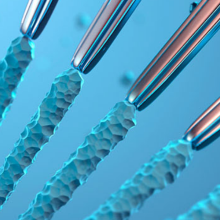Synthetic biology (SynBio) has the potential to transform many aspects of society, the economy, and the environment. This technology is a combination of biology, genetics, programming, and engineering that allows any chemical compound present in nature to be industrialized through purposefully programmed microorganisms to create new products, such as petroleum-free plastics.
As an enabling technology (an invention or innovation that drives massive societal change, such as the computer industry in the 1970s) SynBio is on the cusp of creating a new entrepreneurial ecosystem. But while certain technologies have the potential to create interdependent social, institutional, and organizational networks with interdisciplinary interactions, not all do.
SynBio consists in purposefully programming microorganisms
Esade’s Xavier Ferràs Hernández together with Petra A. Nylund, Luis Pareras (University of Stuttgart), and Alexander Brem (Managing Partner of Invivo Ventures) examined the field of SynBio to achieve an in-depth understanding of the barriers that prevent some enabling technologies from creating these entrepreneurial ecosystems. Their findings, published in the Journal of Business Research, also identify the managerial implications of these barriers.
SynBio as an enabling technology
Biotech companies adopted the use of SynBio in the early 1980s. Its applications have expanded as the technology has matured, from the synthesis of new drugs and therapies to the breakdown of CO2 in the atmosphere. Software companies are increasingly interested in SynBio: major global tech players have invested in the biotechnology, and communities of developers are evolving with a clear market focus.
SynBio applications go from synthesizing new drugs to the breakdown of CO2 in the atmosphere
There are currently seven sub-ecosystems within SynBio: biopharmaceuticals, hardware, smart factories, smart cities, waste management, foodstuffs, and consumer goods.
As the body of knowledge around SynBio expands with a new biomanufacturing workforce, the technologies and best practices within each subsystem will be transmitted throughout the ecosystem and strategic alliances between mature firms, startups, and platform developers will be created to drive growth.
The formation of entrepreneurial ecosystems
Enabling technologies such as SynBio are generators of complex adaptive systems (CAS). CAS are dynamic networks of interactions with multiple elements acting individually while consolidating into one ecosystem. The seminal idea of the enabling technology stimulates complementary innovative products, services, and business models, and new technologies evolve from old ones.
The development and growth of the ecosystem and the CAS can be impacted by multiple factors. The presence and involvement of municipalities, universities and industries, suppliers, consultancies, and government bodies all play key roles.
Enabling technologies stimulate complementary innovative products, services, and business models
To generate an ecosystem, the players within the field of the enabling technology need a clear understanding of the wider systems of these supporting actors, technologies, and interdependencies. By focusing on the single qualitative case study of SynBio, Ferràs and co-authors were able to achieve this understanding.
Structural barriers to ecosystem emergence
Studying SynBio has revealed three types of barriers to entrepreneurial ecosystems based on new enabling technologies: structural, societal, and ethical. These barriers have wider implications for the emergence of new business ecosystems.
The lack of a suitable intellectual property rights framework presents the main structural barrier. SynBio faces the challenge of being a rapidly developing technology with a profound economic and societal impact and myriad cross-sector uses within biology and engineering. The self-organizing structure of the CAS means that intellectual property rights must be protected both within and outside the entrepreneurial system.
However, as was the case with digital systems in the 1980s, this presents a dilemma between the traditional patent model of biotech and the open-source nature of engineering. Is an open intellectual property system, similar to that of IBM’s PC architecture, better to capture the value of an emerging ecosystem? Or is a closed, Apple-style patent system with vertical supply chains preferable?
The main barrier is the lack of a suitable intellectual property rights framework
The cross-sector impact of SynBio technology may turn the slow-paced biotech industry into a more fast-paced software-like sector. However, patenting every stage of development can act as a brake on innovation.
Ethical and societal factors
Societal barriers also pose a challenge to ecosystem emergence. Growth is highly subjective to external factors: the COVID-19 pandemic is a pertinent example of how ecosystem growth can be accelerated to meet societal challenges. However, the rapid regulatory response associated with fast-paced innovations can face strong resistance from the existing structures, practices, and routines of dominant industries.
If the product is an organism, and therefore a life, what are the ethical implications?
The ethical barriers created by unknown uses and consequences of enabling technologies also require attention from managers. In the case of SynBio, if organisms are programmed in the same way as software, should the same intellectual property laws apply?
Enabling technologies require institutional and regulatory work based on complex ethical issues. Principles and regulations surrounding the safety and efficacy of enabling technologies must be clarified — particularly critical in health applications.
Policy development
What legal and strategic approach is more likely to accelerate innovation? Patents and property rights, or open libraries and external communities of developers? If the product is an organism, and therefore a life, what are the ethical implications of creating new life?
The case of SynBio implies fundamental changes in how humans interact with nature and their health concerns and in environmental and socioeconomic risks.
At a policy level, holistic development should support the emergence of entrepreneurial ecosystems, balanced by democratic institutions. Innovation policy should reduce barriers for institutional technologies and focus on the distribution of rent, power, and other benefits of potentially institutional technologies, including SynBio.
Source: Xavier Ferras, ESADE
Contact

Melanie Minderjahn
Career Service - Inner Development, Public Relations


